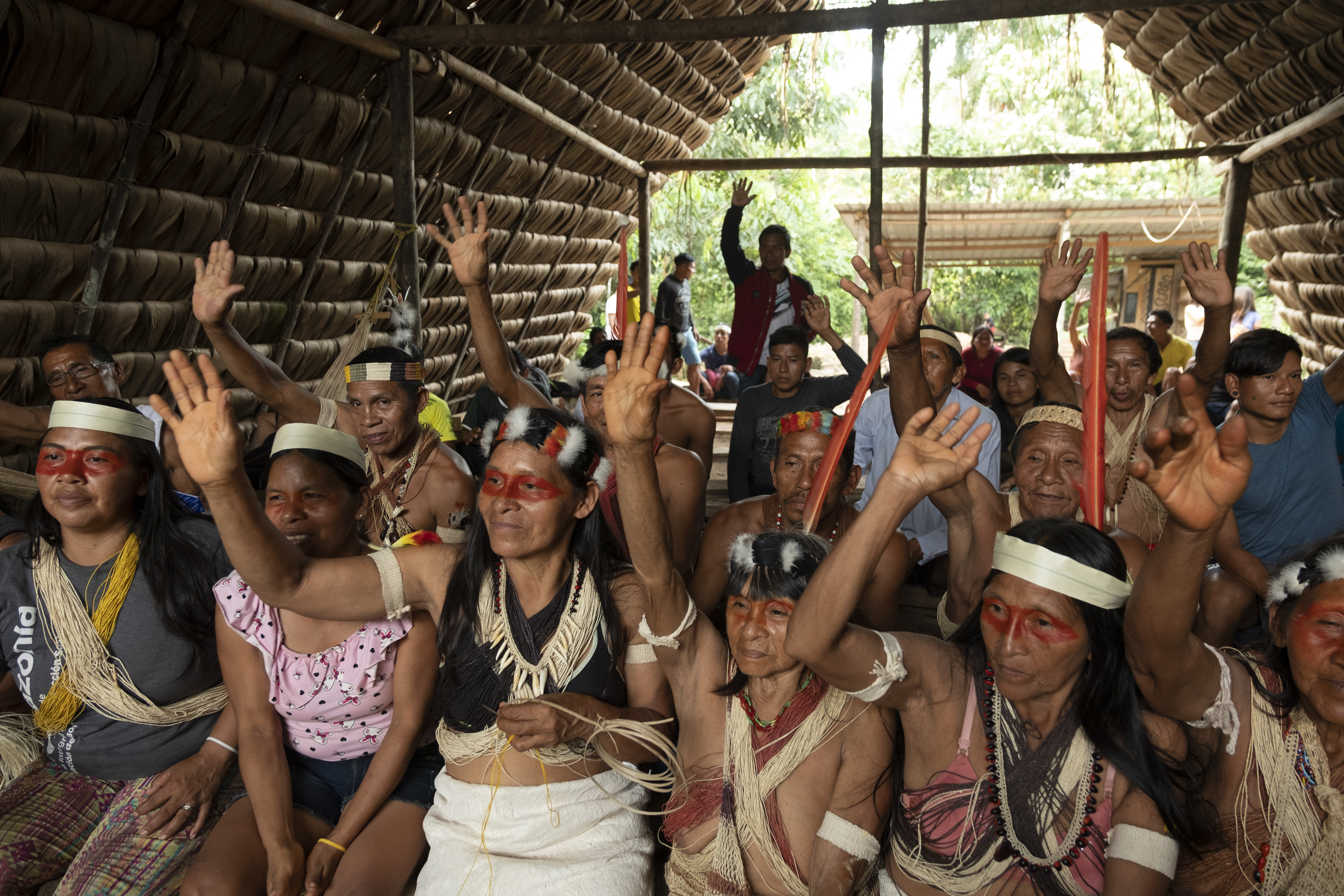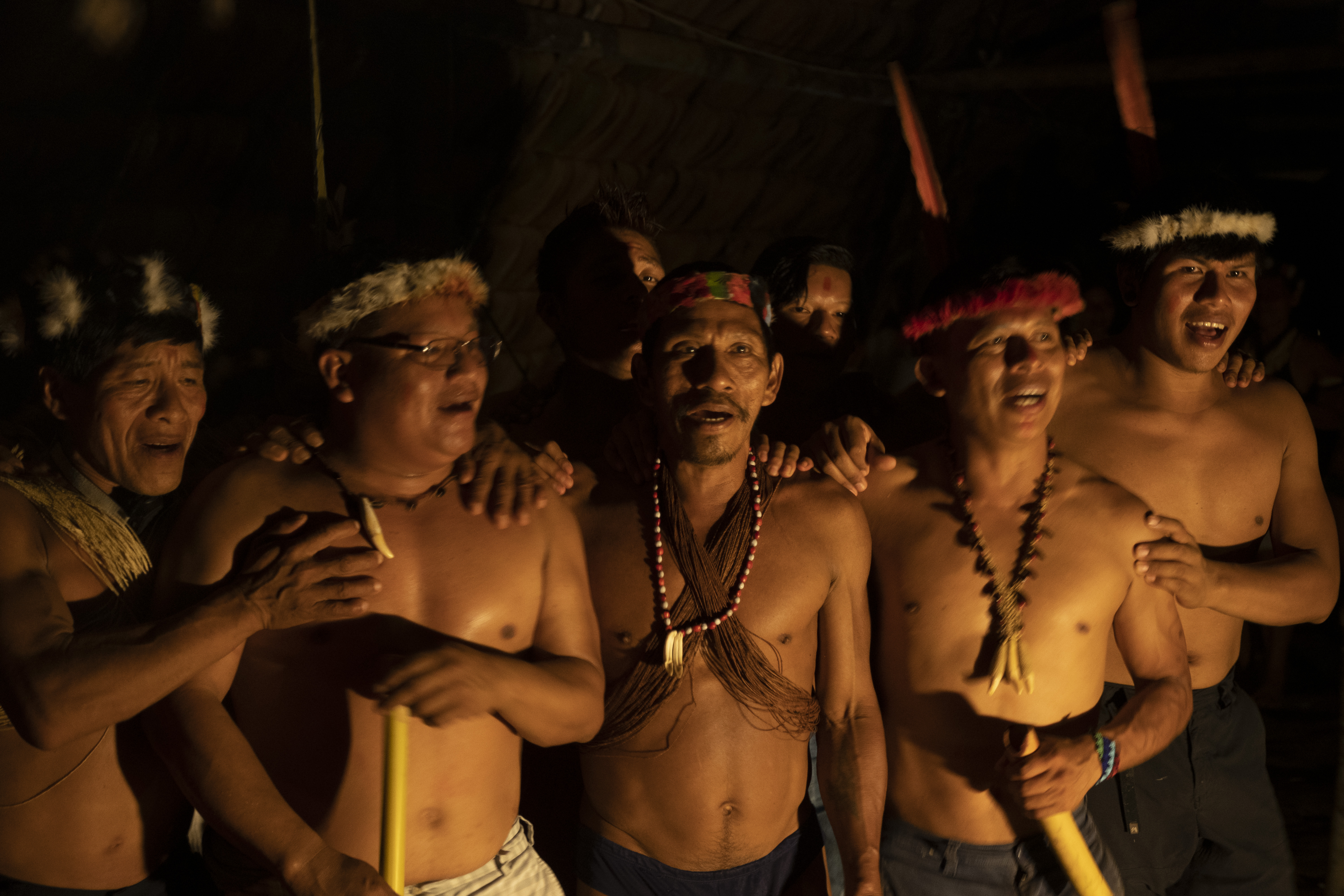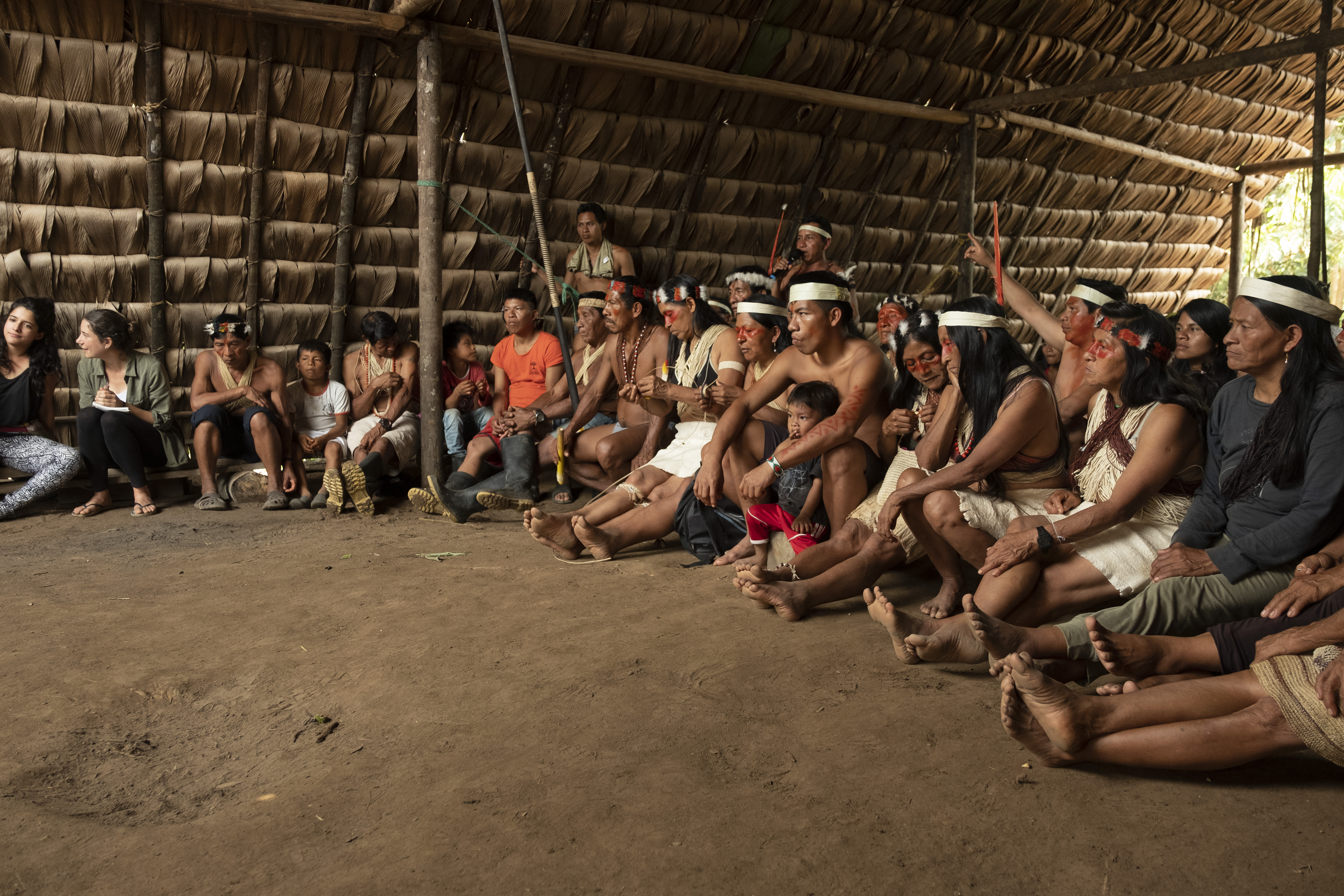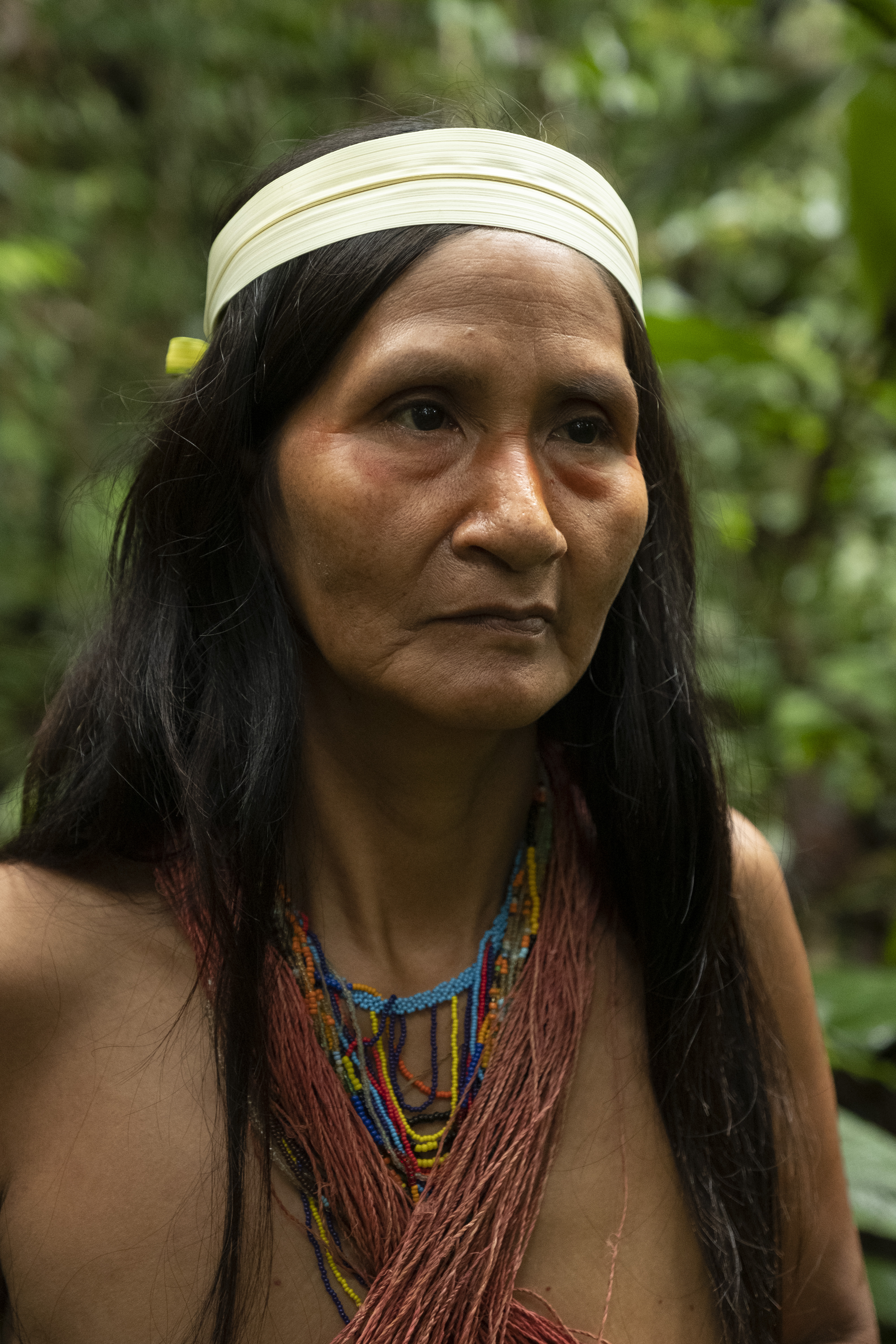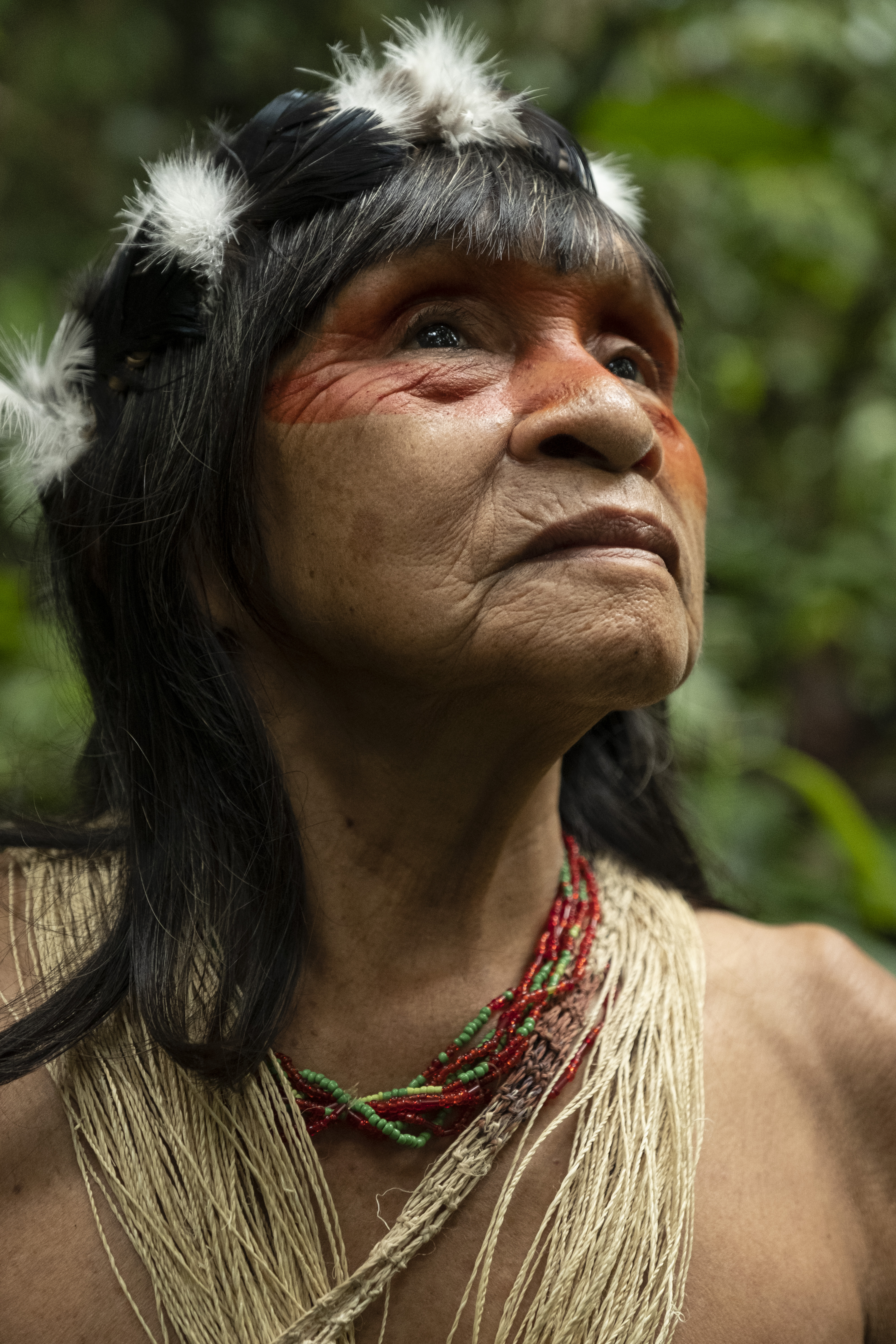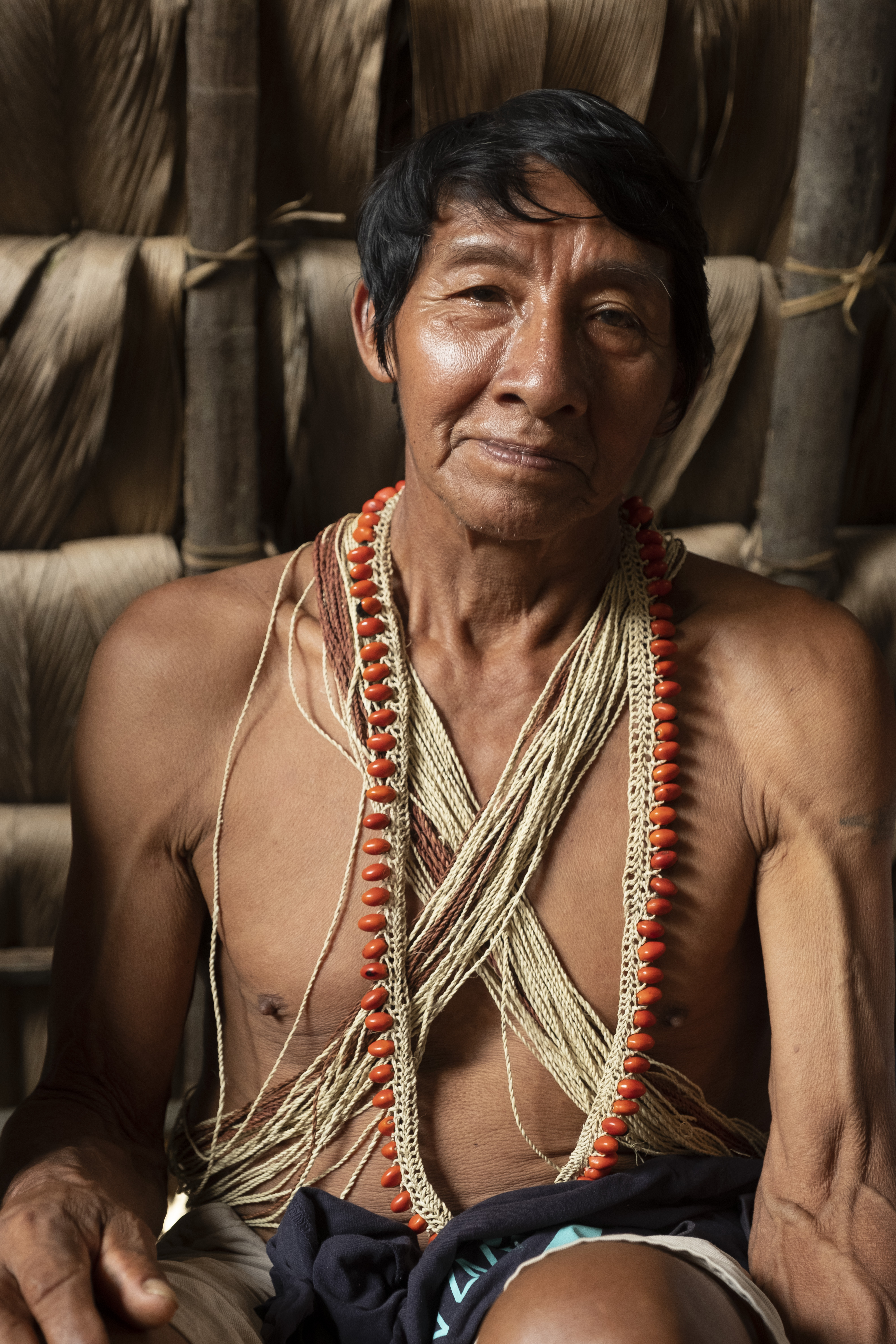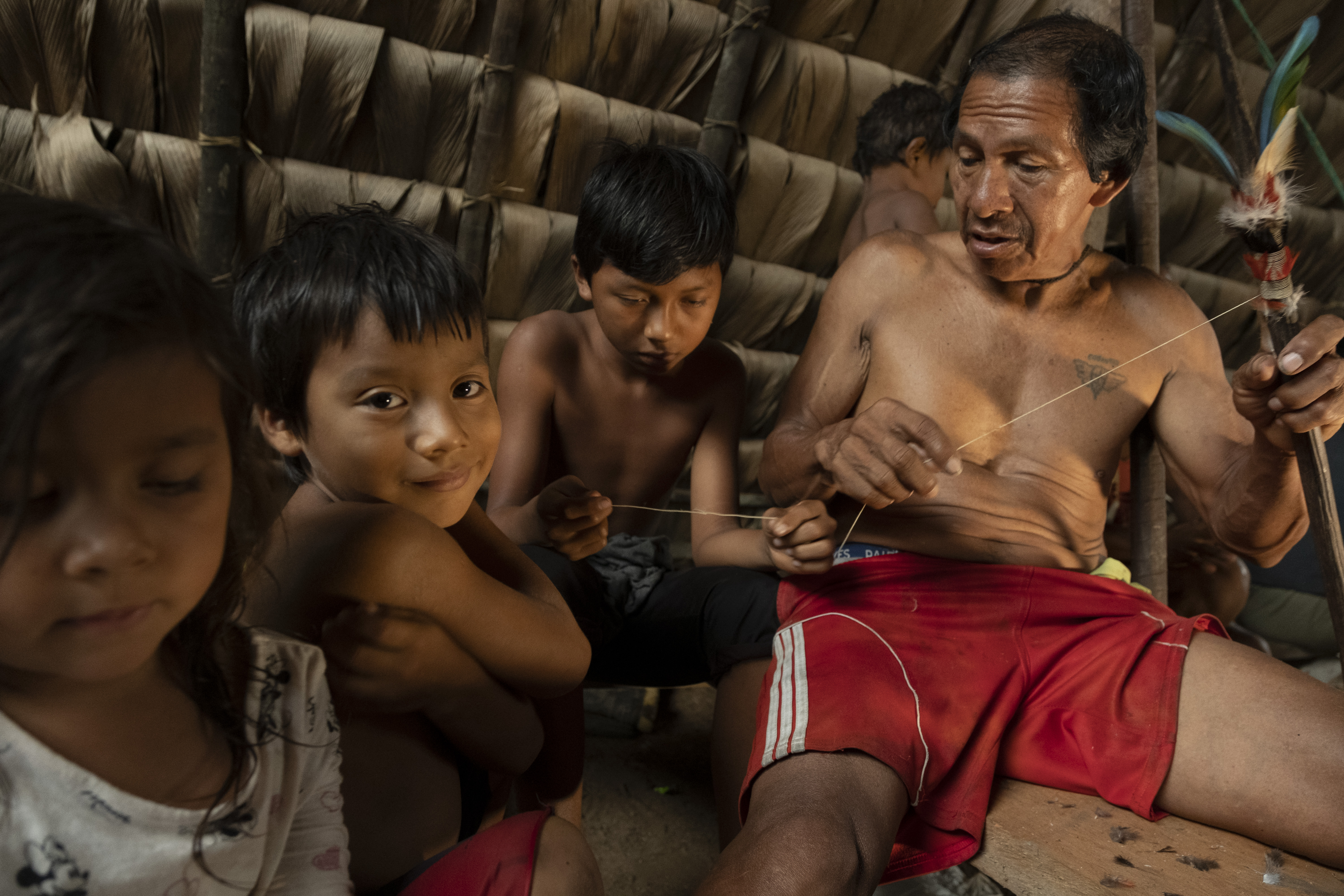Summary
- Education, the bedrock for building a diverse world, is indispensable for the cultural survival and thriving of Indigenous communities, who have a protected right to intercultural education.
- In the Upper Amazon, Indigenous peoples are co-creating their own educational systems in alignment with their cosmovisions, language and culture. These systems directly challenge the colonial logic of dominant schooling methods, and open space for more caring and communal models of learning.
- The future of the Amazon and the planet as a whole rests on our ability to pass down stories and skills of ecological protection to new generations. Decolonizing educational systems is a climate solution.
I. A Crisis of Education
“The school that I dream of for children in Waorani communities is one where they spend some time in the classroom reading and then they’re able to go into the landscape: that is freedom of thought, that allows for the development of children” , says Waorani leader Nemonte Nenquimo.
Across the Upper Amazon, in Waorani territory, communities across the Pastaza province are hard at work dreaming, designing and building an educational model that fits their needs and visions. As Nenquimo explains, “we want to teach our kids through our own education, the stories and forms of organization that our grandparents had, the power to take care of the territory. Our knowledge, our values, our song, our language.”
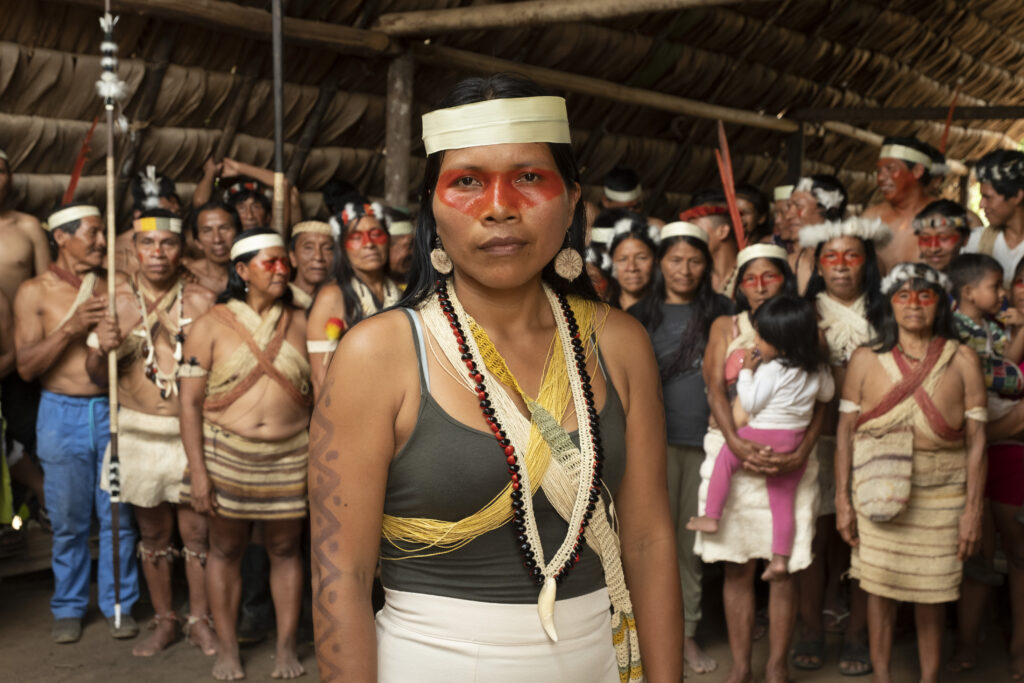
This focus on strengthening education, President of the Waorani of Pastaza organization (OWAP) Silvana Nihua emphasizes, “is a manifestation of our resistance to take care of our culture, knowledge, our children and community.”
Education is what allows us to embody and sustain our culture, to move fluently in our own languages and environments. It grounds our belonging, our identity, our self-esteem and collective resilience: our ability to be with others in place. The struggle over education is at the core of the struggle over the autonomy and self-determination of Indigenous communities and their territory.
Colonialism has involved a comprehensive destruction of memory and the relations that allow for the transmission of memory: education. One of the first maneuvers by colonial actors was to violently eradicate Indigenous educational systems – woven together over centuries by elders and families – and impose a doctrinaire model of brutal assimilation. The colonial mentality behind this conception of ‘education’ was rooted in the racist devaluation of Indigenous knowledge and the supremacist imposition of ‘Western’ ideas above all.
Across the Amazon, for over a century, missionary and evangelical schools taught students to abandon their identity and language. “The missionaries would punish us if we didn’t do as we were told”, explains Nemonte, who left her rainforest home for the first time at age 14 to study at an American evangelical missionary school in the city, and later escaped upon realizing that she was being forced to leave behind her people’s cultural identity and history.
They instilled an education of separation: separation from families and elders, separation from their spirituality and territory, separation between the ‘barbarism’ of Indigenous identity and the ‘civilization’ of Western thought. Education, previously seen as the shared responsibility and task of an entire community, was now to be siloed into a school, overseen by authorities.
The depth and insidiousness of this long colonial legacy has led to a major crisis of education and cultural survival, with many communities continuing to be failed by the schooling system. Across the Amazon region, children and young people are forced to study concepts and material distant from life in the forest and Indigenous culture, using methodologies that generate disconnection. The result: an accelerated loss of Indigenous language and knowledge, and severe inequalities in the development and opportunities available to Indigenous students.
As Amazon Frontlines’ Education Program Coordinator, Patricia Peñaherrera, who works closely with the Waorani, A’i Cofan, Siekopai and Siona nations in their processes of building community-led education, reflects, “for Indigenous communities, their formal education has been so disorientating, so bereft of opportunities to reflect on who they are and want to be, to think about what they want to do with their learning. The result of this process is loss of languages, of traditions, of practices, but also of a clarity around their existence, a sense of purpose. There is a loss of an ability to fully exercise their spirituality, their aliveness. Through education, there is a need to not just recover culture, but re-strengthen it, recover what it means to be Indigenous or Waorani in the face of so much suffocating invasion.”
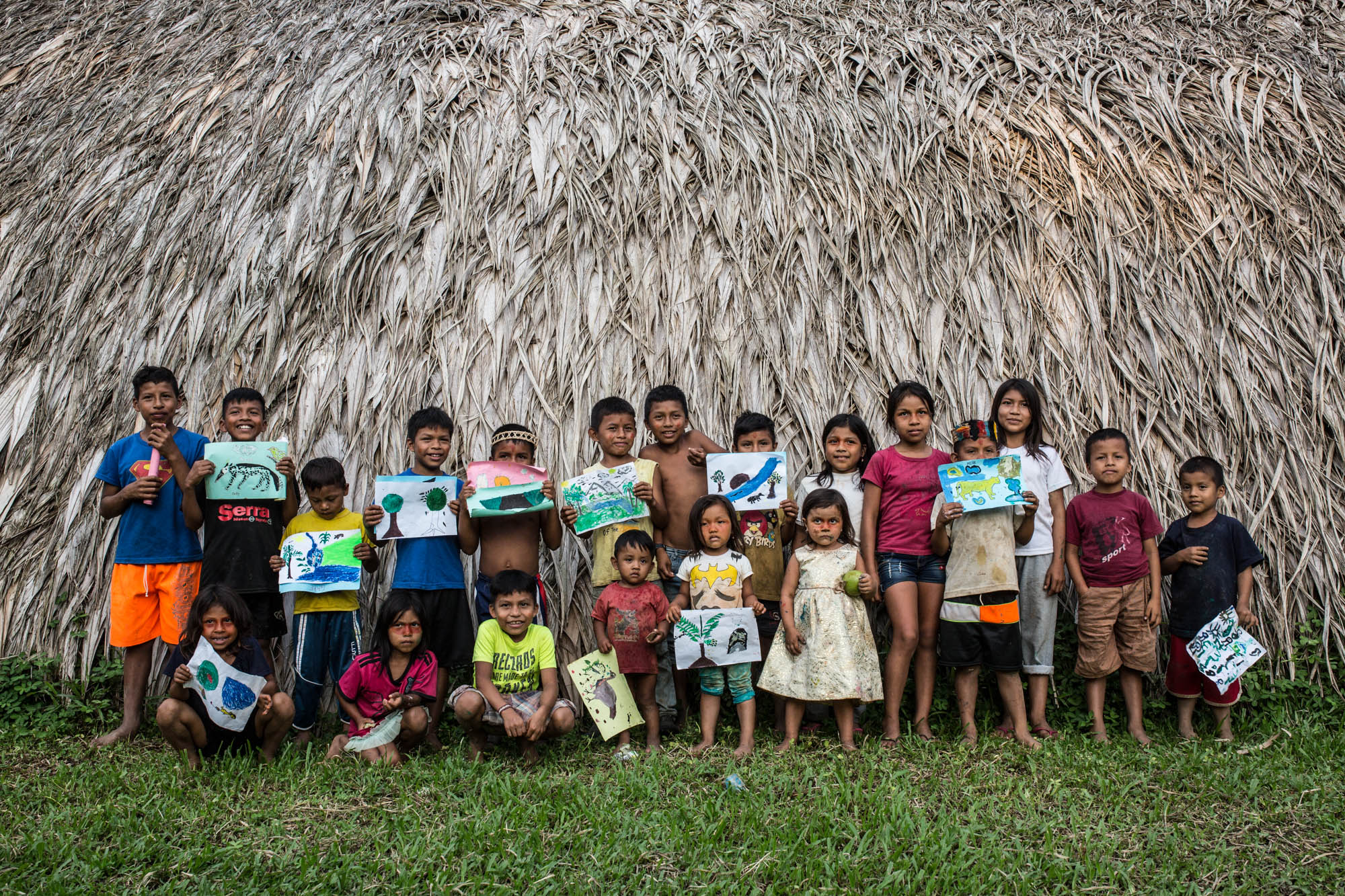
The current educational system in Ecuador continues the colonial inheritance of devaluing ancestral knowledge and Indigenous culture, and imposing distant models maladapted to plural geographies and cultures. Across the board, it fails to offer young people both knowledge of their own community’s territory, history, and culture, and tools from other educational systems. As Waorani leaders Nemonte Nenquimo and Gilberto Nenquimo explain, “the Ecuadorian state designs curricula from the city that make no sense in the jungle: they are curricula that prioritize memorization and not learning, and that teach what is important to cowore – the people outside – without considering what is important to us” .
In 1988, the Ecuadorian Indigenous movements successfully managed to pressure the state to enable a national school system for Indigenous school students, named intercultural bilingual education. Although the right to intercultural education is now well-established, both in Ecuadorian and international law, across the board, the national education system has failed to adequately apply it. High-quality educational materials are scarce. Teachers have been poorly trained. Many are instructed to use online platforms in environments without computers or Internet access. When computers are given, sometimes they are handed to schools without reliable electricity. Underfunded and deliberately neglected, the state’s efforts at intercultural education remain lodged in colonial logics, where the aim of education remains to train students in Western thought, culture and materials. As Peñaherrera reflects, “the dominant objective of all learning remains to be trained in Western knowledge, and to train professionals for a Westernised world”. In practice, the Ecuadorian state, through its educational policies, repeats the reality of no-consultation, in violation of Indigenous peoples’ right to decide.
II. The Waorani Vision for Plural, Indigenous Education
In the heart of their ancestral territory, Waorani communities are working together to radically challenge the colonial model of education, and nourish an Indigenous model of learning. Over the last two years, teachers, parents, and young people from across the Pastaza province have come together in workshops and encounters to co-create the ‘Community Curriculum of Waorani communities’. At one teacher’s workshop, community members defined this Waorani intercultural education system as one that “will help us to take care of our territory and the riches that exist there such as: animals, food, medicines, spirits of our ancestors….We want the children to grow up with love and commitment to their territory, to know both our riches and to master the subjects that come from outside, so that they will be young people determined to take care of our life”.
Through multiple gatherings and co-creation workshops, they have stitched together a rich, bold vision of an education system that works for the Waorani people. This vision presents a radical rupture, in multiple ways, with the dominant-colonial understanding of education prevalent in our societies. The Waorani educational model doesn’t siloe education into the four walls of the school, or into a short period of youth: rather, it sees education as a cross-generational process in and outside of schools, to allow Waorani to feel strength in their identity. That place of strength, through education, becomes a platform to engage with knowledge from other cultures.
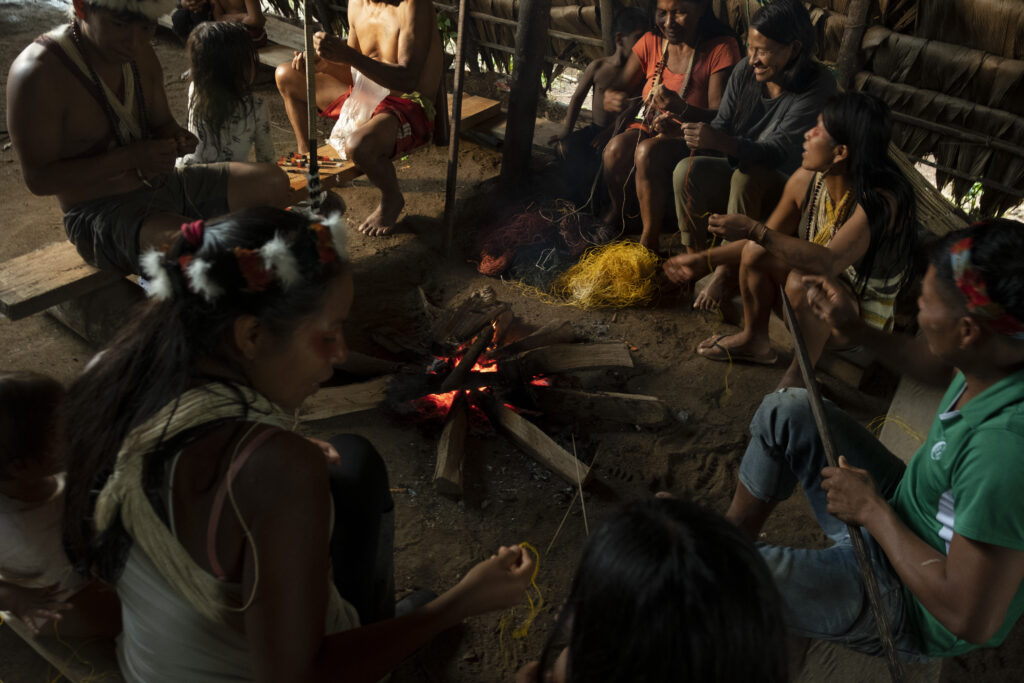
The Waorani vision of education also centres their ancestral rainforest territory as the unifying library of learning. Instead of a strict school day with most activities confined to a chair and desk-filled classroom, the jungle, rivers, trails, food gardens, and community spaces are considered spaces of learning. The territory is a chalkboard for parallel lessons on science, writing, mathematics and spirituality. Challenging the favoritism for intellect in schooling, the Waorani curriculum places the body, sensorial and perceptive intelligence, and movement at the heart of learning.
Materials are selected based on their cultural pertinence. The curriculum balances a mixture of key Waorani knowledges (the Wao Tededo language, conservation techniques, environmental knowledge, spirituality) and methodologies (dialogue with elders, movement, mimicry, immersion, play), with knowledges and methodologies from the cowore (non-Waorani) world, including mathematics, social science and languages (Spanish and English). Mechanical techniques of rote learning and memorisation, are displaced by song, creative play, observation, and imaginative storytelling. Any pedagogical techniques which promote immobility and disencourage autonomy, active learning and experimentation are discouraged. Additionally, education is seen as a connective tissue, intertwined with all issues in the community, from food sovereignty to care for the territory.
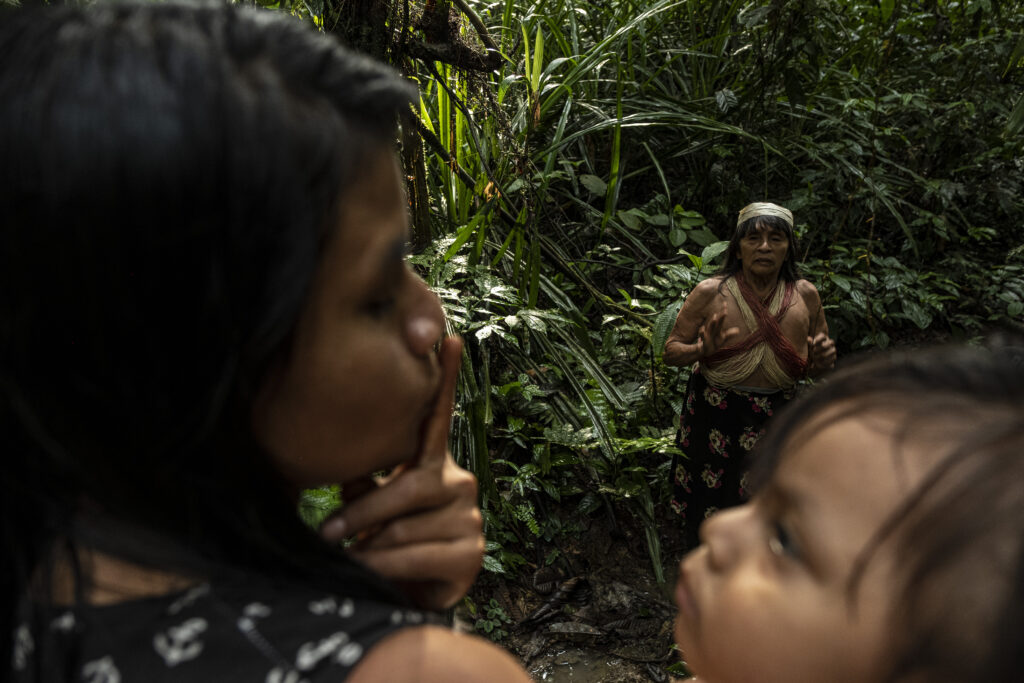
Education is not simply a matter for teachers and students, but for the entire community. The Waorani community plan places enormous emphasis on the role of parents, elders (Pikenani), and families in the transmission of knowledge. Ancestors, animals, plants and insects are also acknowledged as teachers. As the category of who is considered a teacher is stretched, the role of appointed or qualified teachers moves away from being a figure of pedagogical authority, to being a facilitator of community organization, a bridge between communal and non-Waorani knowledges.
Across the board, the ethos is to avoid rigidity, prioritising play, experimentation and liberatory learning. The Waorani model looks at education from a place of plurality, because as Nemonte Nemquimo and Gilberto Nemquimo say, “maybe the boys and girls of the jungle learn in another way…because there is a need for more intercultural thinking in the training of teachers and greater participation of Indigenous peoples in the design of the curriculum”. The vision values individuality and faith in the particular development of each child – adapting learning methods to the uniqueness, needs and rhythms of each person. Shedding a grade-based or age-based structure, children are given the freedom to move between different learning spaces, and find their own level.
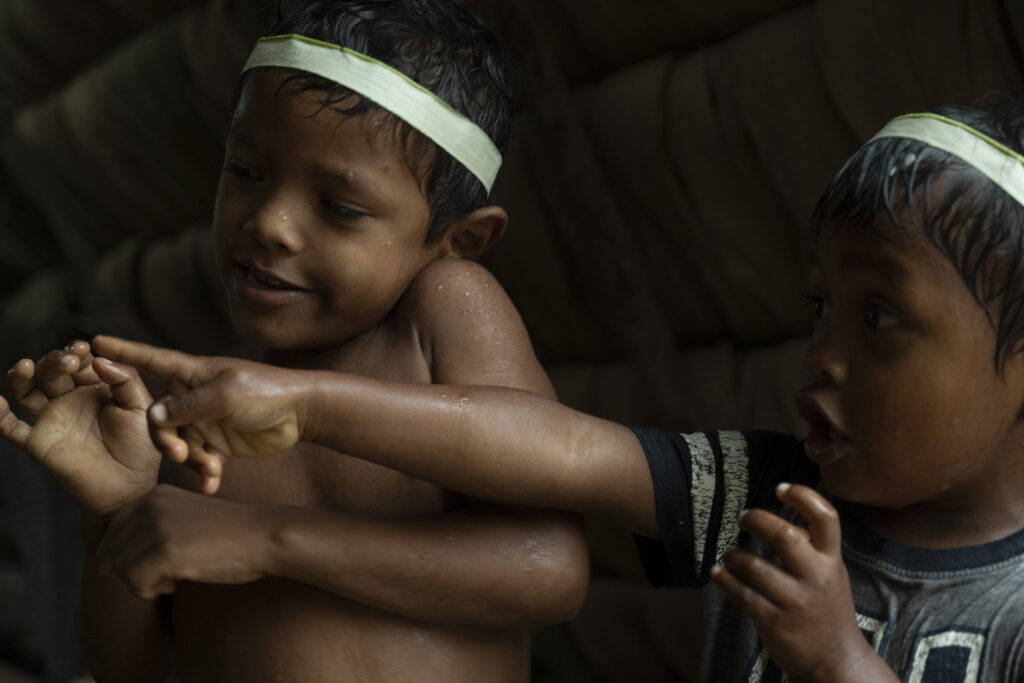
Through these emphases, education is meant to be a space for people to exercise and apply their own rights, strengthening themselves as independent and generative Waorani beings, committed to bringing new ideas to the Waorani people. Education becomes a foundation for bolstering self-governance and autonomy, deepening young people’s connections with their past and ancestral territories, and providing them with skills for navigating a globalizing world.
Already, Waorani communities have started gatherings to strengthen the vision of the curriculum, and opened conversations with relevant ministries. They are calling on the Ecuadorian government to step up, provide resources for infrastructure, support in the development of high-quality intercultural material and training of educators, and ensure stable working conditions for teachers. The Waorani educational vision demands a state committed to collective ‘learning-by-doing’, extending the vision across all Waorani schools.

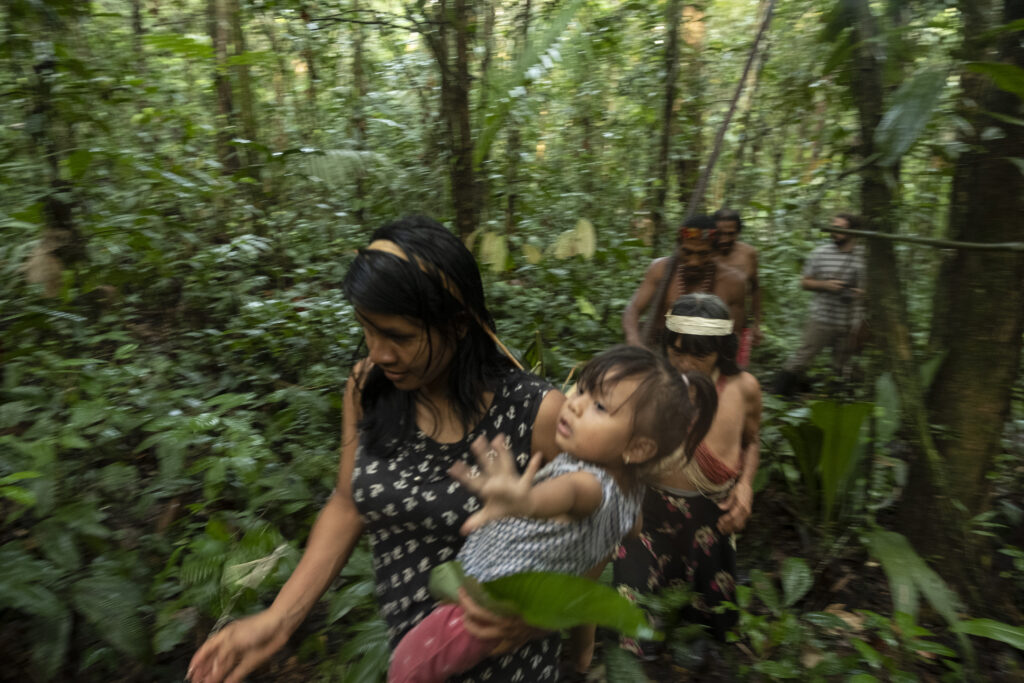
Conclusion
The struggle for education is a transversal struggle for Indigenous communities working to ensure the survival of their own communities and territories. Ensuring the emergence of decolonial models of education is crucial for strengthening the next generation of guardians of the Amazon, our living planet, and the bio-cultural diversity it holds. Across the Upper Amazon, the Ceibo Alliance and Amazon Frontlines have been working with Waorani, Siekopai, A’i Cofan and Siona communities to design their own autonomous educational systems in line with their own heritage and communal priorities.
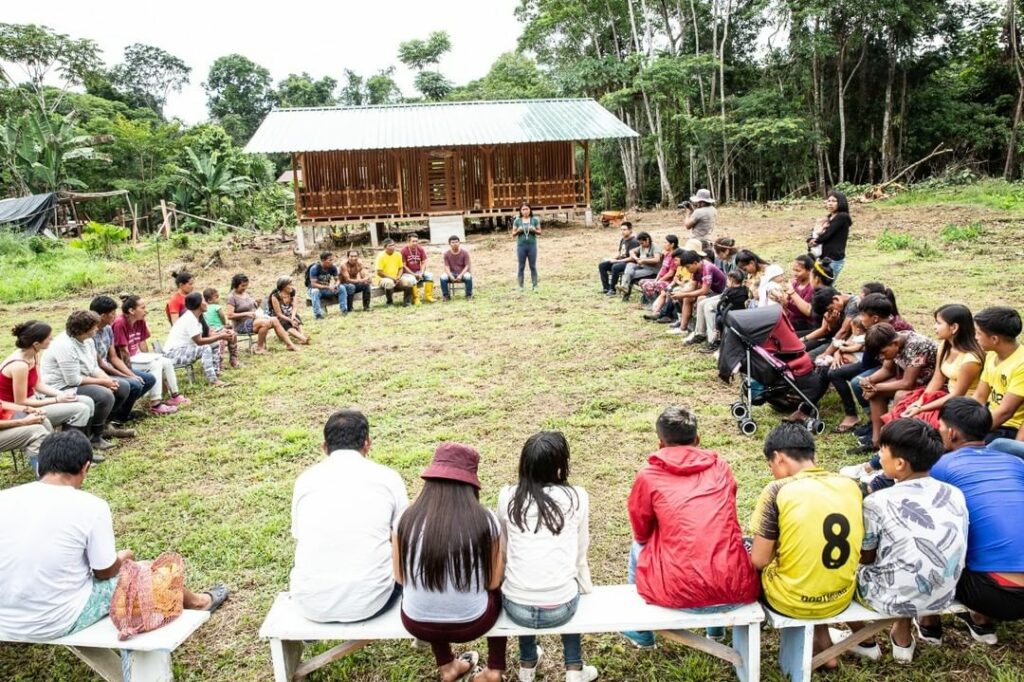
This work, Amazon Frontlines’ Autonomy and Resilience Coordinator Ylenia Torricelli suggests, is also about “fortifying communities in a world of novelties and changes, from climate change to global geopolitical developments.”
With so many threats to peoples and planet, the struggle of Waorani communities shows that education remains our compass, shield and loom for building a plural and protected world. As Nemonte says, “We want the children to grow up strong to face the future, to go forward along the same path that we ourselves have walked. We are also working with people of other nationalities. They also had healthy land once, but their governments and corporations have harmed their rivers. They have lost a great deal of knowledge. We think of our children, and we’re willing to do anything to defend our territory, the jungle. Our home.”

